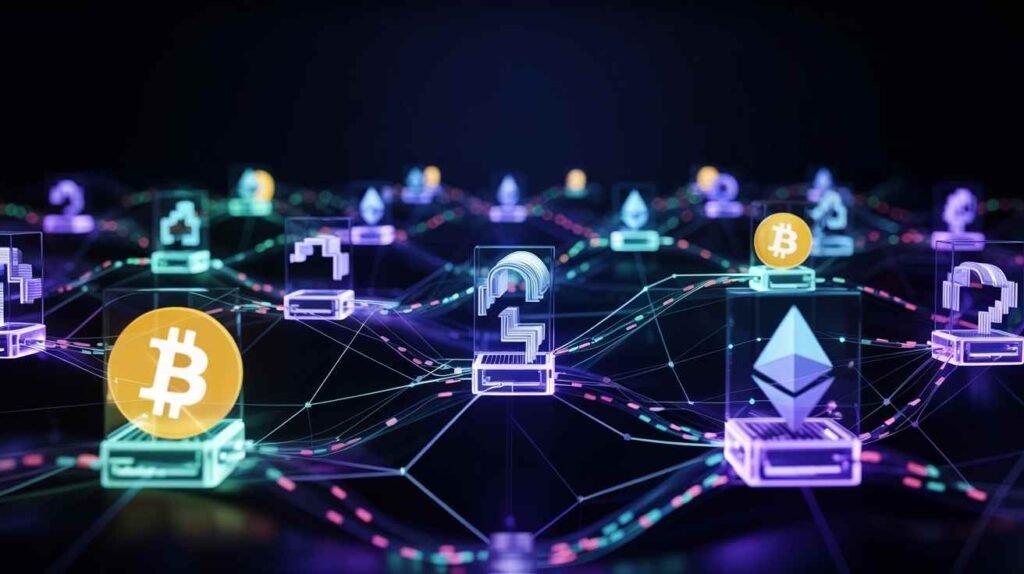
After countless conversations with developers and hours of research, I’ve identified five fundamental principles that make Web3 revolutionary:
1. Decentralization: No Single Point of Control
Web3 applications (dApps) don’t run on single servers owned by one company. Instead, they operate on blockchain networks powered by thousands of computers worldwide. This means no single entity can shut them down, censor content, or change the rules without consensus.
Last year, when certain finance apps were suddenly restricting trading during market volatility, Web3 trading platforms continued operating normally because no central authority could intervene. This resistance to censorship and control is a fundamental feature, not a bug.
2. Native Payments: Money Built Into the Internet
This blew my mind when I first understood it. Web3 integrates payments directly into the protocol through cryptocurrencies. No payment processors, no banks as middlemen, no 3-5 day settlement periods.
My colleague Ryan in Berlin recently sold digital artwork to a collector in Tokyo. The transaction took seconds, cost pennies in fees, and required no bank approval. Try doing that with traditional payment systems!
3. Trustless Interactions: Code Is Law
In Web3, you don’t need to trust the person you’re transacting with or a third-party company. Smart contracts – self-executing code on blockchains – automatically enforce agreements.
Imagine buying concert tickets without worrying about scams. The smart contract guarantees you either get legitimate tickets or your money back – no customer service needed. The rules are transparent and enforced by math rather than middlemen.
4. Ownership Economy: Digital Property Rights
In Web2, you don’t really own your digital assets. Your Twitter followers, Spotify playlists, even in-game purchases can disappear if the platform changes policies or shuts down.
Web3 establishes true digital ownership through NFTs (Non-Fungible Tokens) and other crypto assets that you control via your digital wallet. These assets exist independently of any single platform.
My gaming-obsessed nephew spent hundreds on Fortnite skins that he can never sell or transfer. Meanwhile, my friend’s Web3 game items were recently sold for enough to cover his monthly rent.
5. Permissionless Innovation: Open for Everyone
Anyone can build on Web3 without asking for access. All you need is an internet connection and programming knowledge. This open architecture encourages experimentation and innovation without gatekeepers.# Web3 Explained: The Revolutionary Technology Reshaping Our Digital Future
Last summer, I was catching up with my old college roommate Alex over drinks in San Francisco. He’s been working in tech for years, and I noticed he kept throwing around this term “Web3.” Initially, I nodded along, pretending to understand (we’ve all been there, right?). But after the third mention, my curiosity got the better of me.
“Okay, I give up. What exactly is this Web3 thing everyone’s talking about?”
His eyes lit up. “It’s not just a thing, man. It’s the future of the internet.”
Two hours and several drinks later, my mind was blown. I’ve spent the months since researching, talking to developers, and even investing in a few Web3 projects myself. This article is what I wish someone had shared with me before that night – a straightforward explanation of Web3 without the overwhelming jargon and hype.
What Is Web3? The Evolution of the Internet
Let’s take a quick step back before diving into Web3. The internet we’ve all experienced has gone through distinct phases:
Web1 (1990s-early 2000s): The read-only web. Remember those static websites with blinking text and “Under Construction” GIFs? This was the internet’s childhood – simple, static pages where companies published information, and we consumed it passively. Think early Yahoo, AOL, and basic HTML sites where interaction meant clicking links and maybe submitting a form.
Web2 (mid-2000s-present): The read-write web. Social media explosions, user-generated content, and interactive applications defined this era. Facebook, YouTube, Twitter, and countless mobile apps transformed us from passive consumers to active participants creating content. But there’s a catch – centralized tech giants own our data, control the platforms, and monetize our attention. We get “free” services in exchange for becoming the product.
Web3: The read-write-own web. This is where things get interesting. Web3 represents a fundamental shift in how the internet works, who controls it, and how value moves through it. Instead of corporate giants owning the platforms and data, Web3 distributes ownership among users through blockchain technology, cryptocurrencies, and tokens.
My friend Emily in London put it perfectly: “Web2 was like renting space in someone else’s digital building. Web3 is like getting the deed to your own piece of internet real estate.”
Decentralized Social Media
Social media has dominated Web2, but its centralized control has led to privacy concerns, censorship issues, and data exploitation. In 2025, decentralized social media is emerging as a compelling alternative.
By 2025, decentralized social media platforms are playing a significant role in shaping the digital landscape. With users demanding greater control over their data and content, these platforms continue to grow, offering transparent governance models and community-driven ecosystems.
I’ve been testing a decentralized Twitter alternative for three months now. The difference is striking—I genuinely own my content, can move my social graph between compatible platforms, and earn direct revenue from my posts without a platform taking a massive cut.
My journalist friend Sarah switched entirely to decentralized platforms after repeatedly facing algorithmic demonetization on traditional networks. “It’s liberating,” she told me last week. “My income is more predictable, and I don’t wake up wondering if some mysterious algorithm change will tank my visibility.”
The Tokenization of Everything
One of the most transformative trends of 2025 is the tokenization of real-world assets—turning physical and traditional assets into digital tokens on blockchains.
Properties, artworks, and even corporate debt are becoming more accessible and liquid due to blockchain technology, unlocking untapped markets for a broader range of investors. This democratization of investment opportunities provides diversification and liquidity to portfolio management.
Last month, I invested $500 in a fractional share of a Manhattan commercial property through a tokenization platform. Five years ago, the minimum investment would have been $250,000. The democratization of these markets is creating opportunities for average investors that were previously reserved for the wealthy.
My financial advisor, who was initially skeptical of crypto, now recommends tokenized real estate and bonds as part of a diversified portfolio. “The liquidity premium alone makes these attractive,” she explained during our quarterly review. “Being able to sell your position in minutes instead of months changes the risk profile dramatically.”
Core Principles of Web3 Technology
After countless conversations with developers and hours of research, I’ve identified five fundamental principles that make Web3 revolutionary:
Ready for a Career Change That Could Shape This Technology Revolution?
While researching this article, I discovered something surprising: despite economic uncertainties in other sectors, Web3 job opportunities are booming. Companies are desperately seeking professionals who understand this technology, often paying premium salaries.
Mike, a tech recruiter I interviewed, told me: “The talent gap in Web3 is wider than anything I’ve seen in 15 years of recruiting. Companies are offering 30-40% above market rates for qualified candidates, and they still can’t fill positions fast enough.”
I’ve watched friends with traditional tech backgrounds transition into Web3 roles with remarkable ease. My colleague Jenna pivoted from frontend development to Web3 in just three months of focused study. Her salary jumped 42%, and more importantly, she’s excited about her work again.
By 2025, Web3 education and certification programs have become more widespread, including university courses, online certifications, and specialized training programs. Getting these skills now could position you at the forefront of this technological wave.
In fact, the roles within Web3 have expanded beyond typical development positions. Roles in policy-making, blockchain analytics, decentralized finance strategy, NFT curation, and community management have become more common and accessible.
Live Chat Jobs has recently expanded their online job marketplace to include remote Web3 positions. Whether you’re looking to supplement your income while learning these skills or transitioning fully into a Web3 career, their platform connects qualified individuals with companies building the future of this technology.
Many professionals are finding that remote Web3 positions offer not just competitive compensation, but the flexibility to work from anywhere while participating in building the internet’s future.
Click here to explore Web3 job opportunities that could position you at the forefront of this technological revolution.
Ready to Future-Proof Your Career with Web3 Skills?
While researching for this article, I noticed something striking: there’s a massive shortage of talent in the Web3 space. Companies are desperately seeking professionals who understand this technology, and they’re paying premium salaries.
This talent gap reminds me of the early days of mobile app development, when iOS and Android developers could name their price. But getting these skills requires dedicated learning resources.
Live Chat Jobs has recently expanded their online job marketplace to include Web3 positions that can be done remotely. Whether you’re looking to supplement your income while learning these skills or transitioning fully into a Web3 career, their platform connects qualified individuals with companies at the forefront of this technology revolution.
Many professionals are finding that remote Web3 positions offer not just competitive compensation, but the flexibility to work from anywhere while participating in building the internet’s future.
Click here to explore Web3 job opportunities that could position you at the forefront of this technological revolution.
Real-World Applications of Web3 Technology
Web3 isn’t just theoretical – it’s already creating practical applications that solve real problems:
Decentralized Finance (DeFi): Banking Without Banks
Traditional finance requires mountains of paperwork, waiting periods, and excludes billions of people worldwide. DeFi protocols enable lending, borrowing, trading, and earning interest without banks or financial institutions.
Last month, my cousin in rural Michigan earned 8.5% APY on his stablecoins (cryptocurrencies pegged to the dollar) while his savings account offered a measly 0.5%. Meanwhile, my friend Maria in Barcelona got a collateralized loan in 10 minutes without a credit check – something impossible in traditional banking.
The fintech industry is undergoing major disruption as financial institutions increasingly assist customers in accessing DeFi services through their Web3 financial offerings. By 2025, we’re seeing many financial institutions accepting cryptocurrency as payments with continued Web3 development.
NFTs: Digital Ownership Revolution
Non-Fungible Tokens represent unique digital assets – artwork, music, collectibles, virtual real estate, and more. They’ve enabled creators to monetize directly without platforms taking massive cuts.
A photographer I know struggled for years selling prints through galleries that took 50% commissions. Last year, he sold his first NFT collection directly to collectors worldwide, earning more in a month than the previous two years combined.
Despite the challenges, NFTs have moved beyond simple digital collectibles to find real-world utility. In 2025, we’re seeing NFTs integrated with other technologies like artificial intelligence, unlocking new possibilities for personalized experiences and dynamic art creation.
Decentralized Autonomous Organizations (DAOs): New Ways to Organize
DAOs are internet-native organizations collectively owned and managed by members. Think of them as digital cooperatives with transparent rules encoded in smart contracts.
I recently joined a Creator DAO that collectively funds independent film projects. Members vote on which submissions get funded, and if the films generate revenue, it flows back to DAO members. No studio executives, no opaque decision-making – just creators supporting creators.
In 2025, we’re seeing increased collaboration between DAOs, with interoperable smart contracts enabling seamless interactions across different organizations. This expansion of DAO models is empowering communities and reshaping how organizations are structured and managed.
Identity and Data Sovereignty: You Own Your Digital Self
Web3 is developing solutions for self-sovereign identity, allowing you to control your personal data instead of having it scattered across corporate databases.
My privacy-conscious friend uses a Web3 identity solution that allows him to verify his age for certain services without revealing his actual birthdate or name. This selective disclosure gives him control over his personal information in ways previously impossible.
Challenges and Criticisms of Web3
Anyone promising a technological utopia without acknowledging challenges is selling snake oil. Web3 faces legitimate hurdles:
Technical Complexity and User Experience
Let’s be honest – most Web3 applications are still clunky compared to polished Web2 experiences. Setting up wallets, understanding gas fees, and managing private keys remains intimidating for newcomers.
My tech-savvy sister gave up trying to buy her first NFT after 30 frustrating minutes. Until the experience becomes as seamless as downloading an app from the App Store, mass adoption will remain limited.
In 2025, the industry is actively addressing this challenge. Web3 development is focusing on creating user experiences that hide the technical complexity, making blockchain applications more accessible to non-technical users.
Scalability Issues
Current blockchain networks face limitations in transaction speed and costs. Ethereum, the most popular Web3 platform, sometimes experiences congestion that drives fees to prohibitive levels.
During a popular NFT launch last fall, I watched transaction fees spike to $200 for a simple operation. Layer 2 solutions and new blockchains are addressing these issues, but the technology is still maturing.
The good news is that blockchain has become more efficient thanks to the growth of Layer 2 infrastructure, which sits on top of blockchains and can process transactions “off chain” more quickly while still benefiting from the blockchain’s security.
Regulatory Uncertainty
Governments worldwide are still figuring out how to approach Web3. Some embrace innovation with clear frameworks, while others react with restrictions or bans.
My entrepreneur friend delayed launching her Web3 startup because her legal team couldn’t provide clear guidance on compliance requirements. Regulatory clarity will be essential for mainstream adoption.
The outlook for 2025 is increasingly positive, with the cryptocurrency world stabilizing and showing fewer high-profile fraud cases and exchange failures than in previous years. The sector is experiencing significant activity with growing regulatory clarity in many jurisdictions.
Environmental Concerns
Early cryptocurrencies like Bitcoin consumed significant energy through their consensus mechanisms. While newer protocols have dramatically reduced energy usage through different validation methods, the environmental narrative remains a concern.
In 2025, the industry has made impressive strides in sustainability. Ethereum’s transition to Proof-of-Stake resulted in a massive reduction in the network’s energy consumption, setting a benchmark for sustainability in blockchain development.
Getting Started with Web3: Your First Steps
Ready to dip your toes into Web3? Here’s how I recommend starting:
1. Set Up a Digital Wallet
Your wallet is your Web3 identity and passport. MetaMask is the most popular option for beginners – it’s a browser extension and mobile app that connects you to Web3 applications. Other good options include Coinbase Wallet and Rainbow.
I still remember setting up my first wallet last year – it felt like opening a bank account in a foreign country. Everything was new and slightly intimidating, but after using it a few times, it became second nature.
2. Understand the Ecosystem
Before investing money, invest time in understanding the landscape. Resources I’ve found helpful include:
- Bankless podcast and newsletter
- a16z’s web3 blog
- “The Network State” by Balaji Srinivasan
- “Token Economy” by Shermin Voshmgir
My journey started with just 30 minutes of reading each night. After a month, concepts that initially seemed like alien language became familiar territory.
3. Start Small and Experiment
Allocate a small amount you’re comfortable potentially losing. Use testnet environments (free simulated networks) to practice interactions before using real cryptocurrency.
My first Web3 transaction was buying $50 worth of Ethereum and using a small portion to mint an NFT from an artist I admired. It wasn’t about the investment; it was about experiencing the technology firsthand.
4. Join Communities
Web3 is inherently social. Discord servers and Twitter have active Web3 communities where you can learn, ask questions, and connect with like-minded people.
The moment that changed everything for me was joining a DAO working on a project I was passionate about. Suddenly, I wasn’t just reading about Web3 – I was participating in governance, contributing to discussions, and helping shape a project’s direction.
5. Consider Skill Development
If you’re technically inclined, learning Solidity (the programming language for Ethereum smart contracts) or Web3.js (a JavaScript library for blockchain interaction) can open career opportunities.
JavaScript remains pivotal for Web3 development. As a widely-used language, it offers numerous opportunities and is accessible for beginners. JavaScript skills enable the creation of dynamic websites and applications, a core aspect of Web3.
The Future of Web3: Beyond the Hype Cycle
After months immersed in this space, I’m convinced Web3 represents a fundamental shift in how the internet works. But like all technological revolutions, it will take time, face setbacks, and evolve in unexpected ways.
The early internet was clunky, slow, and limited – yet it transformed our world. Mobile apps initially seemed like toys until they became essential to daily life. Web3 is following a similar trajectory.
As my friend who works at a major blockchain company told me: “We’re building the roads, bridges, and infrastructure now. The killer applications that everyone will use are still being imagined.”
What excites me most isn’t just the technology itself but the values encoded within it: user ownership, creator empowerment, and accessibility. Whether Web3 fully realizes these ideals remains to be seen, but the direction is promising.
The upcoming year might prove to be a watershed moment for Web3 as it finds its footing in real-world applications. While adoption has proceeded more slowly than many industry observers had predicted, technologies surrounding the next generation of the internet continue making significant progress.
Your Next Steps in the Web3 Journey
If you’re intrigued by Web3’s potential, here are three actions you can take today:
- Get educated. Spend 30 minutes exploring resources mentioned above. Understanding precedes participation.
- Set up your first wallet. Even if you don’t add funds immediately, familiarizing yourself with the interface is valuable.
- Explore job opportunities. Whether you’re looking to pivot careers or just earn extra income while learning, check out these remote Web3 positions that match your existing skills with this emerging technology.
The Web3 revolution is still in its early chapters. Those who understand it now will be positioned to thrive as it continues developing. As my developer friend says, “The best time to get into Web3 was years ago. The second best time is today.”
Are you ready to be part of the internet’s next evolution?. Understanding precedes participation.
- Set up your first wallet. Even if you don’t add funds immediately, familiarizing yourself with the interface is valuable.
- Explore job opportunities. Whether you’re looking to pivot careers or just earn extra income while learning, check out these remote Web3 positions that match your existing skills with this emerging technology.
The Web3 revolution is still in its early chapters. Those who understand it now will be positioned to thrive as it continues developing. As my developer friend says, “The best time to get into Web3 was years ago. The second best time is today.”
Are you ready to be part of the internet’s next evolution?



